"Foreigners Who
Changed Japan" Series, Part 1 日本を変えた外国人 I PART 2
Foreigners who changed Japan? I'm sure there are many who would take me to task on my choice of words.
Perhaps for this series it would be better to title it, "Westerners Who
Changed Japan." There were many non-Japanese, of course, who had great
influence on Japan's culture through the centuries -- the relations
between especially China and Korea run very deep. Chinese merchants had
established trading bases in Hirado and Fukuoka in the 11th century.
Piracy and smuggling became a problem to trade in the 14th century, and
the term "wako" was born, though this included not only Japanese but
Chinese and Korean pirates as well.
For example, the great Chinese wako pirate lord, Wang Zhi (Ochoku),
"king of the wako," who ran the largest smuggling and trading operation
in East Asia in the 16th century (headquarters in Hirado from 1542), helped to bring the first Portuguese
into contact with the Japanese via Tanegashima (the subject of my first
story), and then introduce later Portuguese arrivals to Hirado.
There were also Korean scholars, medicine makers and very skilled
craftsmen, such as potters who enabled Japanese artisans in Kyushu
attain to the same level of expertise. Yi Sam-pyeong (aka Kanagae Sanbe),
depending on whose point of view you take, was thought to be one of the
original potters who taught porcelain pottery craft in the late 16th
century in Arita. Others worked and taught in neighboring Imari, and in
Satsuma in southern Kyushu, and in Hagi, just north of Kyushu in
Yamaguchi.
I have, however, chosen the Western foreigner to be central in these
mini-stories, and I hope through them the reader will better understand
just how the West was able to meet the East and be the seeds of amazing
change in the land of Japan.
|
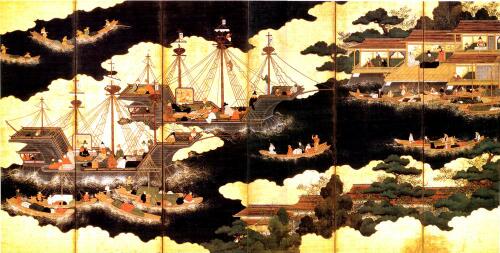
 |
No. 1
Tanegashima
and the Portuguese
第一話:種子島とポルトガル人
|
|
FREE PDF!
 |
In
the year 1543, a Chinese pirate ship was caught in a storm and wandered
in the open sea for 23 days. On September 23, it landed on an island
called TANIXUMAH -- in Japanese, Tanegashima, just south of Kyushu,
near the town of Maenohama.
1543年には、中国の海賊船は嵐に襲われて、23日の間海の上で迷いました。
9月23日に、TANIXUMAHと言う島に上陸しました(現在種子島、前之浜海岸)。
There
were about 100 people on board, including three Portuguese men who
would change Japan and her military forever. Their names were Francisco
Zeimoto, Antonio da Mota and Antonio Pexoto. The young lord of the
area, Tanegashima Tokitaka, was very much interested in the stories
that these Portuguese (aka "southern barbarians" in Japanese) had to
tell about their own country, their ship, their adventures on the seas,
and the Chinese wares they had brought with them.
その船の乗員はおよそ百人がいて、日本と
日本軍隊を永遠に代える3人のポルトガル人、フランシスコ・ゼイモト、アントニオ・ダ・モッタとアントニオ・ペイショットもいました。その地域の若い領主
種子島時堯は、このポルトガル人(「南蛮人」)が自分の国や船や海上の冒険、そして彼らが持ってきた中国製の商品についての物語に、とても興味を持ってい
ました。
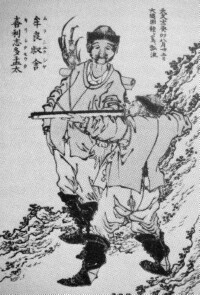 What especially
interested Tokitaka
were the
strange long
objects that these foreigners had -- the arquebuses, or matchlock
muskets. The Portuguese gave a demonstration of the firearm, by aiming
at and hitting a target about 50 meters away. The noise, the smoke, and
the target being hit so far away, certainly must have made a great
impression on the islanders, and earning for the foreigners the
greatest awe and respect by their hosts! Tokitaka wanted to have this
new weapon and paid around 2,000 ryo for a couple of them. Zaimoto, who
was a very good shot with the arquebus, probably taught Tokitaka how to
use the gun as well as how to make gunpowder. What especially
interested Tokitaka
were the
strange long
objects that these foreigners had -- the arquebuses, or matchlock
muskets. The Portuguese gave a demonstration of the firearm, by aiming
at and hitting a target about 50 meters away. The noise, the smoke, and
the target being hit so far away, certainly must have made a great
impression on the islanders, and earning for the foreigners the
greatest awe and respect by their hosts! Tokitaka wanted to have this
new weapon and paid around 2,000 ryo for a couple of them. Zaimoto, who
was a very good shot with the arquebus, probably taught Tokitaka how to
use the gun as well as how to make gunpowder.
特に時堯に興味を起こさせたことは、この外国人が
持っていた不思議な長い品物、すなわち、火縄銃マスケット銃でした。ポルトガル人は銃の実証をして、およそ50メートル離れてターゲットを狙って当たりま
した。銃の轟音煙、そして遠くにあるターゲットを当たって、島民に大きな印象が与えられて、外国人は彼らのホストによって最もものすごい畏怖と尊敬を得る
ことを確かに出来たにちがいありません!
時堯はこの新しい武器をほしくて、銃2丁の為におよそ2,000両払いました。銃狙いが非常に良いゼイモトは、おそらく時堯に銃の利用や火薬を作る方法を
教えたでしょう。
The news of the arrival of the Portuguese travelers
eventually reached the ears of Otomo Sorin, the daimyo of Bungo, who
lived in Funai (modern day Oita). Otomo wanted to meet these strange
men and learn more about their amazing weapons. Funai was eventually to
become a center for international trade with the Portuguese, and
especially Jesuit missionary work, due to a famous priest who visited
there, Francis Xavier.
ポルトガルの旅行者の到着ニュースは、ようやく船井(現代大分市)に住んでいた豊後の大名、大友宗
麟の耳に達しました。
大友は、不思議な南蛮人に会いたくて、彼らの驚くべき武器についてもっと尋ねかったのです。ついに船井は、ポルトガル人との国際貿易中心、特に有名な聖職
者、フランシス・ザビエル、のお訪れで、イエズス会布教の中心になったのです。
In the months that
followed, the Tanegashima blacksmiths learned how to make their own
arquebus, which they called a "Tanegashima Teppo." This first gun was
used to help Tokitaka when he invaded Yakushima and probably helped him
retake that island from an enemy clan.
あとに続いた月々、種子島鍛冶屋は、彼ら自身で火縄銃を製造する方法を学びました。それは、「種子島鉄砲」と呼ばれました。この最初の銃は、おそらく時堯
が屋久島を襲って、敵の藩からその島を取り戻すため、助けに用いられたでしょう。
The
word of the power of this new weapon traveled quickly throughout Japan,
and to a man who would become famous in Japan as one of the three great
generals, and especially for his use of the matchlocks -- Oda Nobunaga.
Nobunaga called the guns "a divine weapon" from the "southern
barbarians" (Lidin, p. 92), and supposedly he had 500 of them made
immediately. He also ordered Toyotomi Hideyoshi to have the nearby
Kunitomo iron workers make a new kind of teppo, a larger gun, which
would be known as the first cannon (ishibiya) in Japan.
この新しい武器の力の話しは
日本中に伝わり、日本偉大な3人将軍のうちの一人として有名になる、特に火縄銃の利用したある男、織田信長、にも伝わりました。信長はその銃が「南蛮人」
から「天の武器」と呼んで、500丁をすぐに作らせたという。
彼も豊臣秀吉に、近くの国友の鉄工員に新しい種類のより大きな鉄砲を作らせるよう命じた。それは日本で初の大砲、「石火矢」、と知られています。
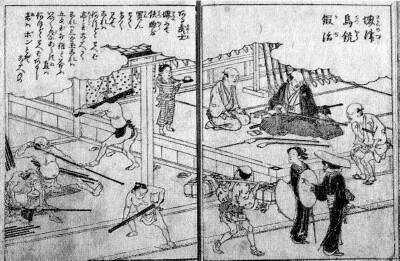 The
Japanese gunsmiths quickly learned how to make and improve these new
weapons -- by 1613, there were some 20,000 cannons and muskets in
Japan! Great military leaders like Oda Nobunaga, Toyotomi Hideyoshi and
Tokugawa Ieyasu all benefited from the use of a weapon introduced into
Japan by a few Portuguese men -- a weapon that played a very important
part in unifying Japan. The
Japanese gunsmiths quickly learned how to make and improve these new
weapons -- by 1613, there were some 20,000 cannons and muskets in
Japan! Great military leaders like Oda Nobunaga, Toyotomi Hideyoshi and
Tokugawa Ieyasu all benefited from the use of a weapon introduced into
Japan by a few Portuguese men -- a weapon that played a very important
part in unifying Japan.
日本の銃工はこれらの新しい武器を製造して、改善する方法を速く学びました。1613年までに、
大砲やマスケット銃約2万丁が日本にあったという!織田信長、豊臣秀吉と徳川家康のような偉大な軍指導者は皆、たった三人のポルトガル人によって日本に紹
介された武器の利用で利益を得た。日本を統一することにおいて非常に重要な役割を果たした武器である。
©2016 Wes Injerd
|
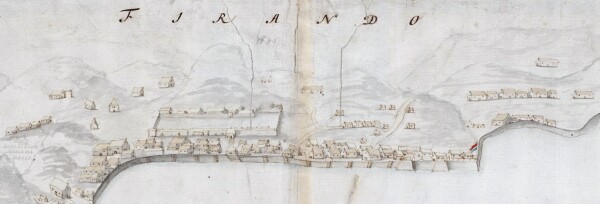
 |
No. 2
The First
Englishman to Japan – Samurai and Hatamoto
- William Adams -
第二話:侍と旗本、日本に初めて上陸したイギリス人
ウィリアム・アダムス
|
|
FREE PDF!
 |
The first Englishman to come to Japan was a British
ship pilot
named William Adams. He was born in 1564 in a town just east of London.
In June 1598, he piloted a Dutch ship, the Liefde,
heading on a voyage around the world. It encountered a storm off the
eastern shores of Kyushu and was driven to the coast off Bungo where
they anchored. After recovering from sickness, Adams along with about
20 other survivors went ashore near modern-day Usuki. The date was
April 19, 1600.
日本に初めて来たイギリス人は、ウィリアム・アダムスという英国の航海士でした。1564年にロンドンの東にある町で生まれています。
1598年6月、フリーデ号というオランダ船で、世界を巡る航海に出、この船を操縦していました。九州の東海岸沖で嵐に遭遇し、豊後の海岸に追いやられま
した。 病気から回復した後に、アダムスはおよそ20人の他の生存者と一緒に、現代の臼杵市の近くに上陸しました。 1600年4月19日の事です。
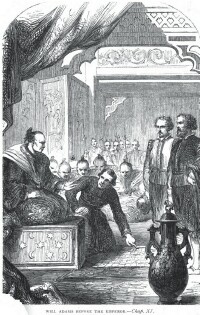 He
was taken to Tokugawa Ieyasu and questioned about many things,
especially why the English and Dutch were at war with the Spanish and
Portuguese. The ship Adams piloted was brought to Ieyasu and the 19
cannons with muskets and ammunition on board were confiscated. Jesuit
records say that these very cannons were used at the Battle of
Sekigahara and helped Ieyasu gain the advantage. He
was taken to Tokugawa Ieyasu and questioned about many things,
especially why the English and Dutch were at war with the Spanish and
Portuguese. The ship Adams piloted was brought to Ieyasu and the 19
cannons with muskets and ammunition on board were confiscated. Jesuit
records say that these very cannons were used at the Battle of
Sekigahara and helped Ieyasu gain the advantage.
彼は徳川家康の下へ連れて行かれて、様々な情報、特にイギリス人とオランダ人がなぜスペイン人とポルトガル人と戦っているのか、などについて尋ねられまし
た。アダムスが操縦していた船は家康の下に持って来られ、船内に積まれていた大砲十九台や火縄銃、弾薬が没収されました。
イエズス会士記録の中では、この大砲が関ケ原の戦いで使われて、家康の優勢に役立つ事になったといわれています。
Adams became quite close to Ieyasu and taught him "some points of
geometry and understanding of the art of mathematics with other
things." Those other things were no doubt geography, navigation,
shipbuilding, and scientific advances in Europe. Ieyasu was so
impressed that he never contradicted what Adams taught him. Ieyasu
changed Adams' name to Miura Anjin and gave him a large estate with
nearly 100 servants, located near present-day Yokosuka, essentially
making Adams a lord over the Japanese. The knowledge Ieyasu received
from Adams had a great influence on how he guided the Japanese people.
アダムスは家康と親しくなって、家康に「幾何学の幾つかの点と数学術の理解と他のもの」を教えました。
その他のものというのは、おそらく地理学、航海術、造船とヨーロッパの進歩した科学でしょう。アダムスが教えたものを決して否定しなかったほど、家康は印
象を受けました。
家康はアダムスに三浦按針という名を与え、百人ほどの使用人と大きな采地(現代の横須賀の近く)を与え、アダムスを旗本にしました。アダムスから得た知識
は、家康がどのように日本を支配していくか、大きな影響がありました。
Adams built two ships for Ieyasu. The first one was an 80-ton ship in
1605 or so, which Adams used to map part of the coast of Japan, helping
in navigation for trade ships. Two years later he built another ship of
120 tons, which Ieyasu gave to be used to take a Spanish diplomat to
Mexico.
アダムスは家康のために船二隻を造船しました。初めのは1605年ごろに80トン級の船でした。アダムスは日本の海岸の地図作製をし、海運船の航行に助け
となりました。また、二年後に120トンの船を作って、家康は、スペインの外交官をメキシコへ連れて帰るために与えました。
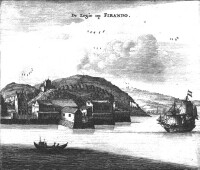 In
September 1609, Adams had such favor with Ieyasu that he was able to
obtain trading privileges for the Dutch in the town of Hirado (called
Firando then) in northwestern Kyushu. This act by an Englishman helped
the Dutch to establish their VOC Trading Office, producing lasting
effects for both the Dutch and the Japanese. Until Perry opened the
doors of Japan, over 600 Dutch ships would visit Dejima in Nagasaki for
trade. The influence of Rangaku
is inestimable. A fellow shipmate of Adams, Jan Joosten, became
middleman for Dutch-Japanese trade and profited greatly. Ieyasu made
him the only "Dutch samurai" in Japan; a section in Tokyo is named
after him, called Yaesu. In
September 1609, Adams had such favor with Ieyasu that he was able to
obtain trading privileges for the Dutch in the town of Hirado (called
Firando then) in northwestern Kyushu. This act by an Englishman helped
the Dutch to establish their VOC Trading Office, producing lasting
effects for both the Dutch and the Japanese. Until Perry opened the
doors of Japan, over 600 Dutch ships would visit Dejima in Nagasaki for
trade. The influence of Rangaku
is inestimable. A fellow shipmate of Adams, Jan Joosten, became
middleman for Dutch-Japanese trade and profited greatly. Ieyasu made
him the only "Dutch samurai" in Japan; a section in Tokyo is named
after him, called Yaesu.
アダムスは、1609年9月に北西部九州の平戸の町(当時フィランドと呼ばれた)で取引特権をオランダ人に得させることができたほどに、家康に気に入られ
ていました。 イギリス人によるこの行為は、オランダ人のVOC貿易館設立に役立ち、オランダ人と日本人の永続的な関係が発生しました。
ペリーが日本の扉を開けるまでには、六百隻以上のオランダ船は取引のために長崎の出島を訪ねます。
蘭学の影響は計り知れません。アダムスの船仲間ヤン・ヨーステンは日蘭取引のための仲介者となり、大いに利益を得ました。
家康は彼をオランダ人でありながら侍にしました。東京のある地名は彼の名をとって名づけられ、八重州と呼ばれています。
In 1610, after the chief interpreter to Ieyasu, Portuguese Jesuit Joćo
Rodriques, was expelled from Japan, Adams became interpreter and trade
negotiator for Ieyasu. Adams, a Protestant, warned Ieyasu of the
machinations of the Roman Catholic Jesuits, which had a great influence
on the eventual closing of Japan to the Portuguese.
1610年に、家康の主要な通訳、ポルトガルのイエズス会士ジョアン・ロドリゲスが日本から追放された後、アダムスは家康の通訳と取引交渉者となりまし
た。プロテスタント教徒アダムスは家康にローマカトリック教会のイエズス会士の陰謀について警告し、それによってポルトガル人の入国禁止政策に大きな影響
がありました。
Having heard about Adams' story, the English sent three ships to Japan
in April 1611 to open trade between the two countries. On June 12,
1613, the Clove, commanded by
Captain John Saris, entered Hirado harbor
-- the first British ship to enter Japan. Adams was summoned and
together with Saris went to Suruga to visit Ieyasu to obtain trading
privileges. This was granted, and in November 1613, the English set up
a trading factory at Hirado. Adams was second in charge, after Richard
Cocks, who later wrote an interesting history on the English settlement.
アダムスの話を聞かされ、英国は、日本との取引を始めるため、1611年4月に船三隻を日本へ派遣しました。
1613年6月12日に、ジョン・セーリス船長率いる最初の英国船クローブ号が平戸に入港しました。アダムスが呼び出され、セーリスと一緒に家康を訪ね、
取引特権を取得するために駿河に行きました。朱印状が与えられ、1613年11月にイギリス人は平戸で取引商館を建立しました。イギリスの開拓地の面白い
歴史を後で書いたリチャード・コックスは商館長で、アダムスは副商館長をしていました。
After Ieyasu died in 1616, Adams continued a good friendship with
Ieyasu's son, Hidetada. Adams married Oyuki, the Christian daughter of
a merchant in Tokyo, Magome Kageyu. Their marriage produced a son named
Joseph and a daughter named Susanna.
家康が1616年に亡くなった後、アダムスは家康の息子秀忠との良い友交を続けました。アダムスは、東京の商人馬込勘解由のキリスト教の娘、お雪と結婚し
ました。 この結婚で、息子ジョセフと娘スザンナが生まれました。
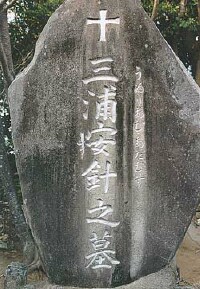 Adams
died in Hirado on May 16, 1620, and was buried there. A memorial was
later built for him in Hemi-mura (now called Anjin-zuka), overlooking
Yokosuka. His wife was said to have been buried there 14 years later. A
district in Tokyo was named after him, called Anjin-cho. Adams, known
as the "English samurai," lived an amazing life as a "shipbuilder,
cartographer, diplomatic negotiator, trader and hatamoto (bannerman) under the
Tokugawa shogunate," (Corr) and noted by Cocks as "having such favour
with two emperors [shogun] of
Japan as never was any Christian in these parts of the world." Adams
died in Hirado on May 16, 1620, and was buried there. A memorial was
later built for him in Hemi-mura (now called Anjin-zuka), overlooking
Yokosuka. His wife was said to have been buried there 14 years later. A
district in Tokyo was named after him, called Anjin-cho. Adams, known
as the "English samurai," lived an amazing life as a "shipbuilder,
cartographer, diplomatic negotiator, trader and hatamoto (bannerman) under the
Tokugawa shogunate," (Corr) and noted by Cocks as "having such favour
with two emperors [shogun] of
Japan as never was any Christian in these parts of the world."
アダムスは1620年5月16日に平戸で亡くなり、そこに葬られました。横須賀を見下ろす逸見村(現在安針塚)に記念碑が後で造られました。十四年後に妻
もそこに葬られたと言われています。アダムスにちなんで名付けられた東京の地区、按針町もあります。「英国の侍で知られているアダムスは、「徳川将軍職の
下での造船家、地図製作者、外交交渉者、貿易家と旗本」として驚くべき人生を送り、「プロテスタント教徒が一人もいない日本という世界の一地域で二人の将
軍に好意を持たれた人」とコックスに言われました。
©2016 Wes Injerd
|
|











